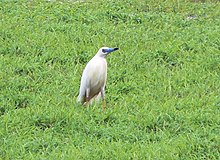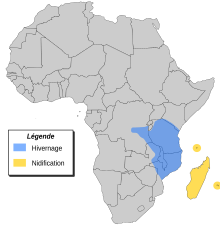Malagasy pond heron
| Malagasy pond heron | |
|---|---|
 |
|
| Scientific classification | |
| Kingdom: | Animalia |
| Phylum: | Chordata |
| Class: | Aves |
| Order: | Pelecaniformes |
| Family: | Ardeidae |
| Genus: | Ardeola |
| Species: | A. idae |
| Binomial name | |
|
Ardeola idae (Hartlaub, 1860) |
|
 |
|
The Malagasy pond heron (Ardeola idae) is a species of heron belonging to the Ardeidae family. They are primarily seen in the outer islands of the Seychelles, Madagascar and countries on the east coast of Africa such as Kenya, Tanzania and Uganda. Being endemic to Madagascar, this species is often referred to as the Madagascar pond heron or Madagascar squacco heron. The population of this heron is estimated at 2,000–6,000 individuals, with only 1,300–4,000 being mature enough for reproductive activities.
The Malagasy pond heron was first described in 1860 by German physician and ornithologist Gustav Hartlaub. His first sighting occurred on the east coast of Madagascar and as such the scientific name of Ardeola idae was formulated thereafter. Being a monotypic species it does not include subspecies or smaller, infraspecific taxa.
Adult Malagasy pond herons grow to a length of 45–50 cm in height and anywhere from 250–350 grams in weight. There is not a large variation in weight between the sexes as they are quite similar in bone body structure. In terms of feather, eye and bill colour the stage of life and reproductive status are the determining factors. The three stages of life are the adult, juvenile and the chick (young).
The adults appearance can be split into the non breeding plumage and the breeding stage. When the species is not breeding, the crown and the posterior are a colour mixture of buff and black with brown prominent over the other parts of the body. The bill is predominately green with a black tip whilst the iris colour is yellow. The flight feathers are clearly seen in flight and for the most part are white. Their lower mantle feathers and upper scapulars are loosely structured and elongated. Moreover, the lower foreneck feathers are split into fine elongated tips, of which cover the upper breast.
The primary difference of appearance in the breeding stage is the dominance of a snow white colour over the body. Coupled with a bill of a deep azure blue the differences between the two adult types are clear. When coming out of breeding, an intermediate plumage emerges on the back. These new brown feathers are not the only change that occurs with dense plumes sprouting on areas such as the neck and breast.
Prior to adulthood, the Malagasy pond heron will possess a juvenile plumage just before leaving the nest of which will last a few weeks. The juvenile differs from the adult in having a dull orange bill and eyes of a pale green nature. The one distinguishing feature of the chick is its thick buff yellow down.
As they often hide in trees and shrubs at the sight of a human disturbance, distinguishing calls between species is often difficult. The Malagasy pond heron possesses two calls, a flight call and a burr call. The flight call has a duration of 0.5s and is used at 5 second intervals as a means to keep distances between other birds in flight. Conversely, the burr call is often noted as the threat call which is used when rival herons approach the nest.
...
Wikipedia

